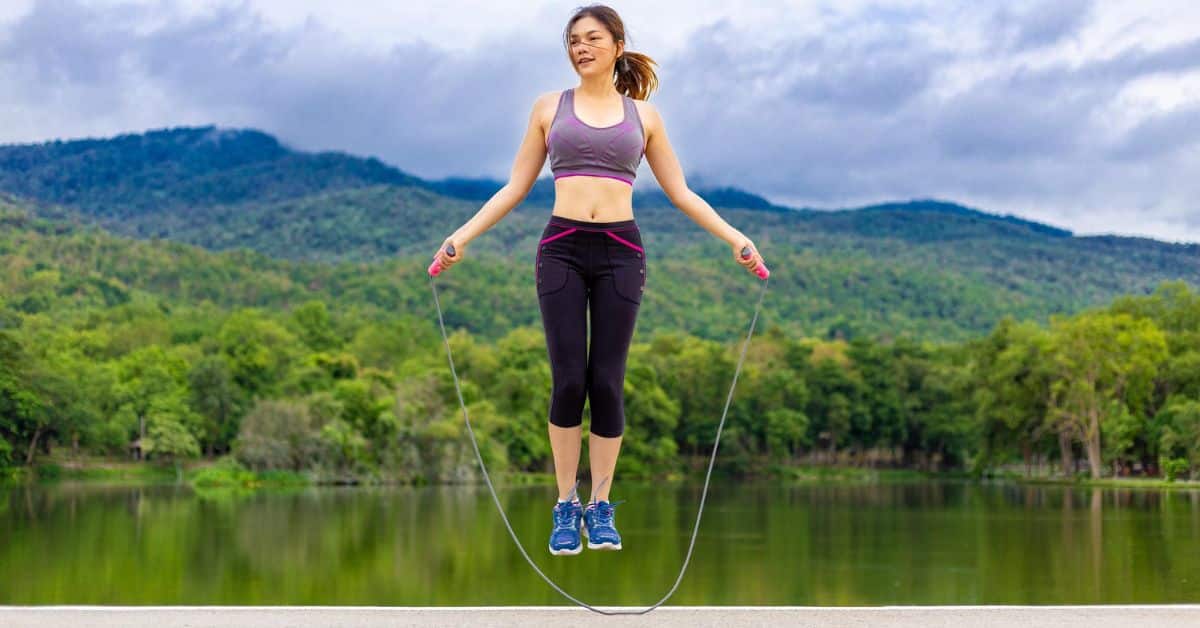
Beginner Jump Rope Workout: Step-By-Step Guide
Jump rope workouts boost cardiovascular fitness while improving coordination and agility. Beginners should try a jump rope workout to incorporate a fun and effective exercise into their daily routine. Jumping rope burns calories, but it also improves endurance and strength, so it is a versatile exercise. Whether you’re a novice or coming back to fitness after a break, this workout can be tailored to your needs. You can engage in a full-body workout that challenges your mind and your body with just a rope. In this article, we’ll cover essential techniques for beginner jump rope workouts, a structured workout plan, and tips for getting started with jump rope training. Let’s dive in.
Beginner Jump Rope Workout: Step-by-Step Guide
Jump rope is a fantastic way to get a full-body workout, improve coordination, and build cardiovascular endurance. For beginners, it’s important to start slowly and focus on technique before progressing to more intense routines. Here’s a step-by-step guide to help you get started.
Step 1: Choose the Right Jump Rope
Before you begin, make sure you have the right jump rope. The rope should be the correct length for your height. To check, stand in the middle of the rope and pull the handles up. They should reach your armpits. If it’s too long, you can tie knots near the handles to adjust the length.
Step 2: Warm Up
Before starting your workout, warm up your muscles to prevent injury. Spend 5-10 minutes doing dynamic stretches or light cardio, such as walking, arm circles, and leg swings. This will loosen your body and raise your heart rate.
Step 3: Practice Basic Form
Mastering the basics will ensure you jump safely and effectively:
- Hold the rope correctly: Grip the handles lightly with your palms facing forward. Keep your elbows close to your body, and use your wrists to spin the rope rather than your arms.
- Stand tall: Maintain a good posture with your back straight, core engaged, and shoulders relaxed.
- Jump lightly: Focus on small, quick jumps, just enough to clear the rope. Land softly on the balls of your feet to reduce the impact on your joints.
Step 4: Start with Basic Jumps
Begin with simple two-footed jumps. Keep your jumps low to the ground and aim for a smooth rhythm:
- Hold the rope behind you and swing it over your head.
- Jump as the rope passes under your feet, keeping your knees slightly bent.
- Repeat for 30 seconds to 1 minute. If you get tired, stop, rest, and resume when ready.
Step 5: Gradually Increase Duration and Speed
As you become more comfortable, increase the duration of your jumping sessions. Aim to jump for 1-2 minutes at a time, with short breaks in between. You can also work on increasing your speed for a more intense workout.
Step 6: Add Variations
Once you’ve mastered the basic jump, introduce variations to keep your workout interesting and challenge different muscle groups. Here are a few beginner-friendly variations: For example, try alternating your feet in a scissor-like motion as you jump or incorporate double-unders, where the rope passes under your feet twice in one jump. These small tweaks can elevate your routine and help you build stamina and coordination. Pairing these variations with total gym workouts for beginners creates a well-rounded fitness plan that targets multiple muscle groups and keeps your sessions engaging.
- Single-foot jumps: Alternate hopping on one foot at a time.
- High knees: Jump while lifting your knees toward your chest.
- Side-to-side jumps: Move laterally while you jump, shifting your weight from side to side.
Step 7: Cool Down
After completing your jump rope workout, take a few minutes to cool down. Stretch your calves, hamstrings, shoulders, and wrists to help your muscles recover and reduce post-workout soreness.
Step 8: Set Goals and Track Progress
Consistency is key to improving your jump rope skills. Set small goals, such as jumping for a longer duration or mastering a new variation. Track your progress to stay motivated and see your improvements over time.
Common Challenges and Solutions

Starting a jump rope workout can present some challenges, especially for beginners. The following are some common obstacles you might face and how to overcome them.
Difficulty with Coordination
Many beginners struggle to time their jumps with the rope’s swings, which often leads to tripping or stumbling during workouts. To improve, practice the rope’s rhythm without jumping. Swing the rope in front of you while timing your jumps.
Land as the rope approaches your feet. Once you feel comfortable with the timing, gradually incorporate jumps. Focus on small, controlled jumps to enhance coordination. With consistent practice, your coordination will improve.
Fatigue and Stamina Issues
Jumping rope can be exhausting, especially for beginners. It’s common to feel winded quickly during your first few sessions. Start with shorter intervals, like 15-20 seconds of jumping. Follow this with longer rest periods of 30-60 seconds.
As your stamina builds, increase the jumping duration gradually. You can also reduce your rest time. Consistency is key to improving your endurance. Over time, you will notice significant progress in your stamina.
Injury Concerns
Jumping rope can stress your joints, leading to discomfort or injury. This is particularly true if proper form isn’t maintained. Focus on landing softly on the balls of your feet. Keep your knees slightly bent to absorb impact.
Always warm up before your workouts to prepare your body. Consider jumping on softer surfaces, like gym mats, to reduce joint stress. Listening to your body is crucial. If you experience pain, take a break and reassess your form.
Boredom or Lack of Motivation
Performing the same jump rope routine can become monotonous. This can make it hard to stay motivated over time. To combat this, incorporate variety into your workouts. Mix up jump styles like basic bounce, side swings, or criss-cross jumps.
You can also combine jump rope with bodyweight exercises. Set specific fitness goals and track your progress regularly. Celebrating milestones can also help keep your motivation high.
Limited Space or Equipment
Not everyone has access to a large area or specialized jump rope equipment, which can make workouts challenging for some beginners. For convenience, choose a jump rope that fits your space constraints.
You can adapt workouts to include bodyweight exercises that require less room. If jumping rope isn’t feasible, consider shadow jumping. This technique mimics the motion without using a rope, and it’s a great alternative to maintaining your workout routine.
FAQs
Is jump rope good cardio?
Yes, jump rope is an excellent cardio workout. It effectively increases your heart rate, improving cardiovascular health. Jumping rope can burn more calories than running at the same time. It engages multiple muscle groups, enhancing overall fitness.
Additionally, it improves coordination, balance, and agility. Regular jump rope sessions can boost your endurance and stamina. It’s a versatile exercise that can be done almost anywhere. Incorporate it into your routine for a fun and effective cardio option!
How many calories does a jump rope burn?
The number of calories burned while jumping rope varies depending on several factors. Generally, a person can burn about 10-16 calories per minute, depending on their weight, intensity, and jump rope style.
For example, a 150-pound individual may burn around 15 calories per minute. If you jump for 30 minutes, that totals about 450 calories. Adjust your intensity and duration for greater calorie burn. Tracking your workout can help you monitor your progress!
How long should a jump rope be?
The ideal jump rope length depends on your height. A general guideline is to choose a rope that reaches your armpits when you stand on its center. For precise measurements, stand on the rope’s center and pull the handles upward. The handles should reach your armpits. Here are some quick guidelines:
- Under 5’0″: 7’0″ rope
- 5’0″ to 5’5″: 8’0″ rope
- 5’6″ to 6’0″: 9’0″ rope
- Over 6’0 “: 10’0” rope Adjustments can be made based on personal preference!
How long should I jump rope?
The duration of your jump rope sessions depends on your fitness level and goals. For beginners, start with 5-10 minutes of jumping, broken into short intervals. You can gradually increase this as your stamina improves.
Try to jump continuously for 15-30 minutes during a moderate workout. Advanced jumpers can push for 30-60 minutes for more intense sessions. Incorporate rest periods to prevent fatigue. Listen to your body and adjust the duration based on your comfort and fitness level!
Is jumping rope bad for knees?
Jumping rope can be tough on your knees, especially if proper form isn’t used. The impact of jumping can stress the joints if you land too hard. However, it can be safe for most people when done correctly.
To protect your knees, focus on landing softly on the balls of your feet. Keep your knees slightly bent to absorb shock. Additionally, consider jumping on softer surfaces, like a gym mat. Always listen to your body and modify your routine as needed!
Read More: What Muscles Do Burpees Work
The Takeaway
Jump rope workouts offer numerous benefits for beginners. They enhance cardiovascular fitness, coordination, and overall strength. Starting slowly and practicing proper techniques is essential for success. Overcoming challenges will boost your confidence and skills.
Remember to incorporate variety to keep your workouts engaging. Stay consistent, and you’ll see significant improvements over time. If you enjoy the experience, you will achieve many benefits from jump rope training. Get started today, and make jump rope a fun part of your fitness routine!



